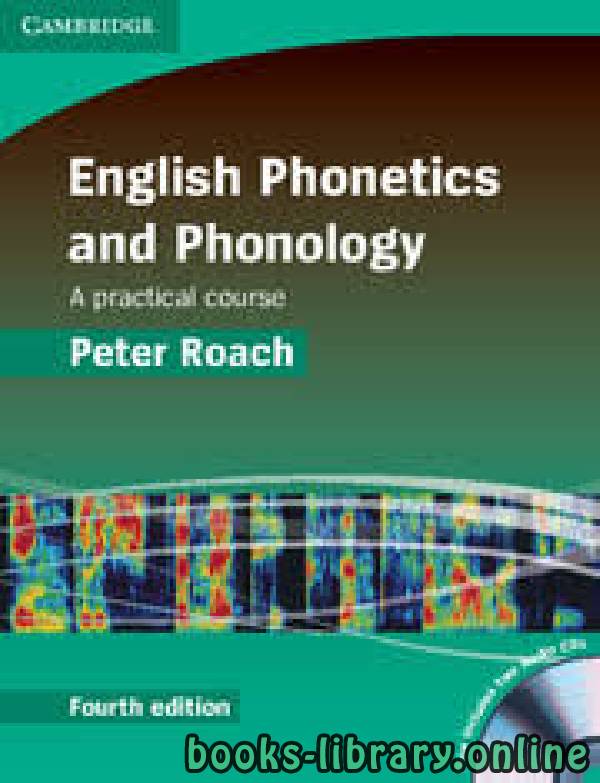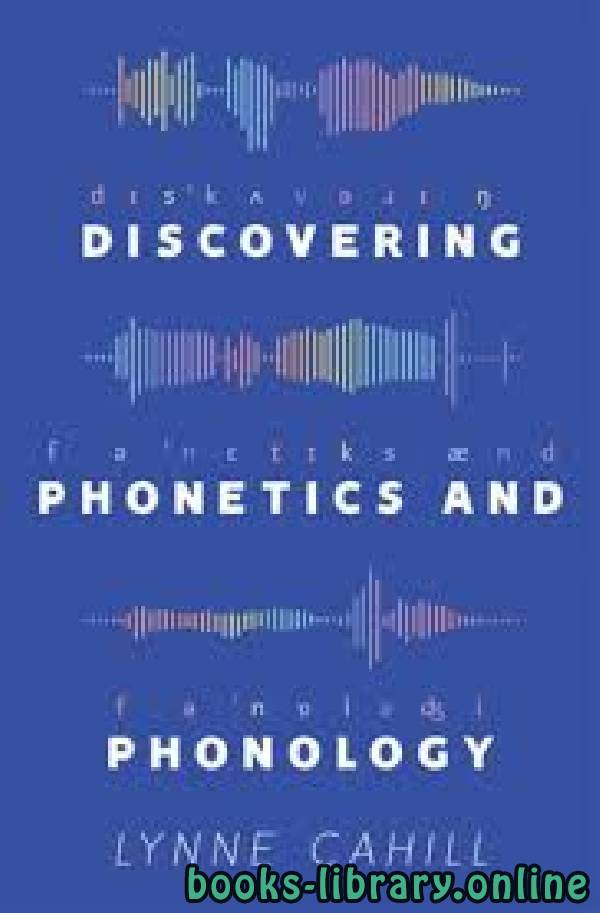كتاب Phonetics and Phonology 4
4 Phonetics and Phonology In this chapter we sketch the pronunciation system of English. We begin with phonetics, a system for describing and recording the sounds of language objectively. Phonetics provides a valuable way of opening our ears to facets of language that we tend to understand by reference to their written rather than their actual spoken forms. Phonology concerns itself with the ways in which languages make use of sounds to distinguish words from each other. Teachers should be knowledgeable about the phonetics and phonology of English because (1) the sound system is primary and the basis for the spelling system; (2) they may have to teach English pronunciation to students who are not native speakers of English; (3) they may have to teach poetry, which requires that they teach about rhyme, alliteration, assonance, and other poetic devices that manipulate sound; (4) it is important to understand accents and language variation and to react appropriately to them and to teach appropriate language attitudes about them to students (see our chapters on Language and Society and Usage in Book II); (5) we are so literate that we tend to “hear” the sounds of our language through its spelling system, and phonetics/phonology provides a corrective to that; and (6) phonetics and phonology provide systematic and well-founded understandings of the sound patterns of English.Delahunty and Garvey - ❰ له مجموعة من الإنجازات والمؤلفات أبرزها ❞ Phonetics and Phonology 4 ❝ ❱
من صوتيات Phonetics كتب تعلم اللغة الإنجليزية - مكتبة كتب تعلم اللغات.

قراءة كتاب Phonetics and Phonology 4 أونلاين
معلومات عن كتاب Phonetics and Phonology 4:
In this chapter we sketch the pronunciation system of English. We begin
with phonetics, a system for describing and recording the sounds of language objectively. Phonetics provides a valuable way of opening our ears to
facets of language that we tend to understand by reference to their written
rather than their actual spoken forms. Phonology concerns itself with the
ways in which languages make use of sounds to distinguish words from each
other.
Teachers should be knowledgeable about the phonetics and phonology
of English because (1) the sound system is primary and the basis for the
spelling system; (2) they may have to teach English pronunciation to students who are not native speakers of English; (3) they may have to teach
poetry, which requires that they teach about rhyme, alliteration, assonance,
and other poetic devices that manipulate sound; (4) it is important to understand accents and language variation and to react appropriately to them
and to teach appropriate language attitudes about them to students (see our
chapters on Language and Society and Usage in Book II); (5) we are so literate that we tend to “hear” the sounds of our language through its spelling
system, and phonetics/phonology provides a corrective to that; and (6) phonetics and phonology provide systematic and well-founded understandings
of the sound patterns of English.
سنة النشر : 2015م / 1436هـ .
عدد مرات التحميل : 10640 مرّة / مرات.
تم اضافته في : الثلاثاء , 24 ديسمبر 2019م.
حجم الكتاب عند التحميل : 0.3MB .
تعليقات ومناقشات حول الكتاب:
هذا القسم يحتوى علي كل ما يتعلق بعلم الصوتيات.
الصوتيات أو علم النطق أو علم الأصوات الكلامية هو أحد فروع علم اللسانيات، يُعنى بالجهاز الصوتي ومخارج أصوات الكلام الإنساني وتبويبها. كان الخليل بن أحمد الفراهيدي أول عالم صوتيات عربي والقاموس الذي كتبه فيه أول تصنيف لأصوات اللغة العربية. لكل لغة نظامها الصوتي الخاص بها التي يمكن كتابة أصواتها بنظامها الكتابي أو بالألفبائية الصوتية الدولية الصوتية (IPA) التي تمّكن دارسي اللغات من نطق أصواتها أو التعرف عليها.
تتألَّفُ اللغة من أصوات تجتمع لتُعبِّر عن الأشياء الحسِّيَّة والأفكار المجرَّدة، ويعتمد تصنيف الأصوات اللُّغويَّة على دراسة كيفيَّات الأصوات وطرائق تحقُّقها وإصدارها والآليَّات التي تدخل فيها والأعضاء التي في إنجازها، أي على المعرفة الدقيقة بأعضاء النطق، وعلى الفهم العلميّ لعمليَّة الكلام...
تنقسم الأصوات اللغوية إلى قسمين: الأصوات الصامتة أو الساكنة حرف صامت والأصوات المصوتة أو الصائتة أصوات اللين حرف مصوت.
Phonetics is a branch of linguistics that studies the sounds of human speech, or—in the case of sign languages—the equivalent aspects of sign. It is concerned with the physical properties of speech sounds or signs (phones): their physiological production, acoustic properties, auditory perception, and neurophysiological status.
Phonetics as a research discipline has three main branches:[2]
Articulatory phonetics: the articulation of speech[3]
Acoustic phonetics: the acoustics of speech
Auditory phonetics: the perception of speech
Phonetic insight is used in several applied linguistic fields such as:
Forensic phonetics: the use of phonetics for legal purposes
Speech recognition: the analysis and transcription of recorded speech by a computer system
Speech synthesis: the production of human speech by a computer system
Phonology, on the other hand, is concerned with the abstract, grammatical characterization of systems of sounds or signs and how they pattern in and across languages. Phonology has been argued to relate to phonetics via the set of distinctive features, which map the abstract representations of speech units to articulatory gestures, acoustic signals or perceptual representations
contents
1 History
2 Consonants
2.1 Place of articulation
2.1.1 Labial consonants
2.1.2 Coronal consonants
2.1.3 Dorsal consonants
2.1.4 Radical consonants
2.1.5 Glottal consonants
2.2 Manner of articulation
3 Vowels
3.1 Vowel features
3.1.1 Vowel height
3.1.2 Vowel backness
3.1.3 Lip position
3.1.4 Minor features
4 Acoustic and auditory phonetics
5 Anatomy
5.1 The larynx
5.2 Pulmonary and subglottal system
6 Voicing and phonation types
7 Articulatory models
8 Sign languages
9 Transcription
Phonetics and Phonology
In this chapter we sketch the pronunciation system of English. We begin
with phonetics, a system for describing and recording the sounds of language objectively. Phonetics provides a valuable way of opening our ears to
facets of language that we tend to understand by reference to their written
rather than their actual spoken forms. Phonology concerns itself with the
ways in which languages make use of sounds to distinguish words from each
other.
Teachers should be knowledgeable about the phonetics and phonology
of English because (1) the sound system is primary and the basis for the
spelling system; (2) they may have to teach English pronunciation to students who are not native speakers of English; (3) they may have to teach
poetry, which requires that they teach about rhyme, alliteration, assonance,
and other poetic devices that manipulate sound; (4) it is important to understand accents and language variation and to react appropriately to them
and to teach appropriate language attitudes about them to students (see our
chapters on Language and Society and Usage in Book II); (5) we are so literate that we tend to “hear” the sounds of our language through its spelling
system, and phonetics/phonology provides a corrective to that; and (6) phonetics and phonology provide systematic and well-founded understandings
of the sound patterns of English.
types of phonetics
examples
sounds
english
pronunciation
books
Definition of Phonetics
learn English
 مهلاً !
مهلاً !قبل تحميل الكتاب .. يجب ان يتوفر لديكم برنامج تشغيل وقراءة ملفات pdf
يمكن تحميلة من هنا 'تحميل البرنامج'

نوع الكتاب : pdf.
اذا اعجبك الكتاب فضلاً اضغط على أعجبني و يمكنك تحميله من هنا:


كتب اخرى في صوتيات Phonetics

The 44 Sounds (Phonemes) of English PDF
قراءة و تحميل كتاب The 44 Sounds (Phonemes) of English PDF مجانا

Phonetics & Phonology An Introduction PDF
قراءة و تحميل كتاب Phonetics & Phonology An Introduction PDF مجانا






